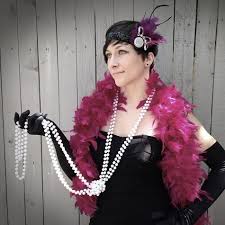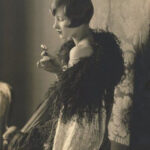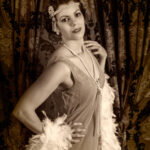
Accessories were all the rage in the 1920s, not only for flappers, but the population in general. The most famous (or perhaps, infamous) were decorative headbands, waist-length strings of pearls, long cigarette holders, and feathered boas.
Feathers and boas were nothing new. Feathers are generally thought to signal that your guardian angel is nearby. White feathers symbolize  protection, while black can mean finding your life's purpose. The bird a feather comes from can also influence its meaning. For example, dove feathers mean peace, while owl feathers mean wisdom.
protection, while black can mean finding your life's purpose. The bird a feather comes from can also influence its meaning. For example, dove feathers mean peace, while owl feathers mean wisdom.
Feather boas trace their origins back to ancient civilizations where feathers were revered for their beauty and perceived mystical qualities, and seen as symbols of divine connection, power, and spiritual elevation. The Egyptians used feathers prominently in their cultural and religious headdresses to signify their communication with the gods. In ancient Mesoamerican cultures, feathers were often reserved for the elites and the priests who wore elaborate feathered costumes during important rituals.
More recently, feather boas became popular fashion items in 19th-century Europe. By the Victorian Era, the trend had blossomed into a full-on craze, when boas emerged as a symbol of exotic luxury and sensuality among dancers, actresses, and those in the upper echelons of  society seeking to make a bold fashion statement. Boas were cat's meow from New York City to Hollywood where celebrities such as Josephine Baker and Marlene Dietrich were regularly seen draped in expensive, elaborate feathers.
society seeking to make a bold fashion statement. Boas were cat's meow from New York City to Hollywood where celebrities such as Josephine Baker and Marlene Dietrich were regularly seen draped in expensive, elaborate feathers.
The Roaring 20s witnessed the pinnacle of feather boa popularity, particularly among the flappers. These rebellious young women, known for their bold fashion choices and liberated lifestyles, embraced feather boas as symbols of freedom and defiance against societal norms and their restrictions.
Today, boas have re-emerged as symbolic in LGBTQ+ communities, representing a history of defiance, freedom, and pride. Often seen at Pride parades and drag shows, feather boas in rainbow hues or extravagant styles celebrate identity and self-expression
Fun Fact #1. Modern boas are most often made with synthetic feathers. For “true” feather boas, the feathers predominantly come from turkeys that are killed for their meat. A lightweight chandelle (smaller feathers or "flats" from the turkey) boa might only weigh 65 grams (2.3 oz), whereas a 24 ply ostrich boa can weigh as much as 200 grams (7.1 oz). The more ply, the fluffier, thicker, and expensive the boa. Ostrich feathers are the most popular and expensive feathers used in making feather boas. They are soft, fluffy, and come in a variety of colors. They are also very durable.
Fun Fact #2. Henri Bendel (1868-1936), founder of the once famous NYC store, claimed to have invented the feather boa. As there are paintings of women in feathery scarves that predate his birth, that seems unlikely. In 1888, a man named Rehul T. Bene of Hoboken, New Jersey, filed a patent for “certain new and useful improvements in the manufacture of feather boas.”